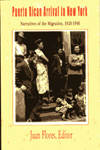 “First to disembark were passengers traveling first class, businessmen, well-to-do families, students. In second class, where I was, there were the emigrants, most of us tabaqueros, or cigar workers. . .”
“First to disembark were passengers traveling first class, businessmen, well-to-do families, students. In second class, where I was, there were the emigrants, most of us tabaqueros, or cigar workers. . .”
Thus writes Bernardo Vega in this collection of engaging and readable first-hand reminiscences about the mid-twentieth-century migration from Puerto Rico to the U.S. The documentary importance of these testimonies is evident, particularly in their capturing of the actual voyage from Puerto Rico and arrival in New York. Unlike more recent writings about the migration, where attention is riveted on the later process of settlement and intergenerational adjustment, the older narratives dwell on the psychological and existential trauma of arrival and first impressions.
In this collection, the element of class difference within the migrating population stands out sharply. While in subsequent literature such issues become more intricate and representation of the social classes more oblique, these early texts show that it was a divided arrival. For despite the structural uniformity and overwhelmingly working-class composition of the immigration, Puerto Ricans came to New York with divergent interests and understandings depending on their class.
Contributors include Bernardo Vega, Juan B. Huyke, Jesus Colon, and Guillermo Cotto-Thorner.
